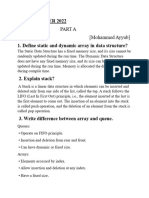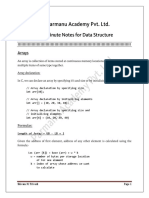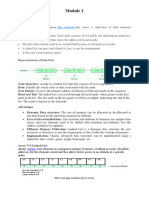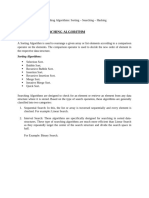Linked List Searching Sorting Notes
Uploaded by
wopinis387Linked List Searching Sorting Notes
Uploaded by
wopinis387Linked Lists, Searching, and Sorting in C++
1. Linked Lists
Linked Lists are linear data structures where elements (nodes) are connected using pointers.
They allow dynamic memory allocation and efficient insertions/deletions.
Types:
1. Singly Linked List: Each node points to the next node.
2. Doubly Linked List: Each node points to both the next and previous nodes.
Operations on Linked Lists:
1. Insertion: Add elements at the start, end, or arbitrary positions.
2. Deletion: Remove elements from the start, end, or arbitrary positions.
3. Traversal: Visit each node to process or display its data.
Key Advantages:
1. Dynamic size adjustment.
2. Efficient memory utilization.
1.1 Singly Linked List Example (C++)
class Node {
public:
int data;
Node* next;
Node(int value) { data = value; next = nullptr; }
};
class SinglyLinkedList {
private:
Node* head;
public:
SinglyLinkedList() { head = nullptr; }
void insertAtEnd(int value) { ... }
void traverse() { ... }
void deleteAtStart() { ... }
void deleteAtEnd() { ... }
};
2. Searching Algorithms
Searching involves finding a target value in a collection.
1. Linear Search:
- Sequentially checks each element for the target value.
- Time Complexity: O(n).
2. Binary Search:
- Divides the search space into halves and searches in the sorted array.
- Time Complexity: O(log n).
3. Sorting Algorithms
Sorting involves arranging elements in a specific order.
1. Bubble Sort:
- Repeatedly swap adjacent elements if they are in the wrong order.
- Time Complexity: O(n^2).
2. Selection Sort:
- Find the minimum element and place it at the beginning.
- Time Complexity: O(n^2).
3. Insertion Sort:
- Build the sorted portion one element at a time.
- Time Complexity: O(n^2).
4. Quick Sort:
- Partition the array and recursively sort the partitions.
- Time Complexity: O(n log n).
5. Merge Sort:
- Divide the array into halves, sort them, and merge.
- Time Complexity: O(n log n).
4. Complete Example: Linked List with Sorting and Searching
The following code demonstrates a complete implementation of a singly linked list
with insertion, deletion, traversal, sorting (Bubble Sort), and searching (Linear and Binary).
Refer to the full code in the study material for implementation details.
You might also like
- The C# Player's Guide - 5th Edition - 5.0.083% (18)The C# Player's Guide - 5th Edition - 5.0.0497 pages
- Ap Computer Science Principles Practice Exam and Notes 2021100% (4)Ap Computer Science Principles Practice Exam and Notes 2021108 pages
- Hacking The Art of Exploitation 2nd Edition Jon Erickson100% (19)Hacking The Art of Exploitation 2nd Edition Jon Erickson492 pages
- M.C.a. (Sem - II) Paper - I - Data StructuresNo ratings yetM.C.a. (Sem - II) Paper - I - Data Structures132 pages
- Class Note 2: Data Structures and AlgorithmsNo ratings yetClass Note 2: Data Structures and Algorithms2 pages
- #2 Arrays, Linked Lists, Selection SortNo ratings yet#2 Arrays, Linked Lists, Selection Sort41 pages
- Lecture 4 - Link List - Rules and List ImplementationNo ratings yetLecture 4 - Link List - Rules and List Implementation21 pages
- A QUEUE Is Logically A First in First Out (FIFO or First Come First Serve) Linear Data StructureNo ratings yetA QUEUE Is Logically A First in First Out (FIFO or First Come First Serve) Linear Data Structure4 pages
- Data Structure Calicut University 2nd SemNo ratings yetData Structure Calicut University 2nd Sem20 pages
- Fundamentals of Data Structure: - Niraj Agarwal100% (1)Fundamentals of Data Structure: - Niraj Agarwal176 pages
- Detailed Linked List Searching Sorting NotesNo ratings yetDetailed Linked List Searching Sorting Notes7 pages
- Name: P Surya Narayana Subject: Summer Internship Section: K18Uw REG NO: 11802507 Course Code: Cse443 Topic: Dsa Self PacedNo ratings yetName: P Surya Narayana Subject: Summer Internship Section: K18Uw REG NO: 11802507 Course Code: Cse443 Topic: Dsa Self Paced33 pages
- ADVANCED DATA STRUCTURES FOR ALGORITHMS: Mastering Complex Data Structures for Algorithmic Problem-Solving (2024)From EverandADVANCED DATA STRUCTURES FOR ALGORITHMS: Mastering Complex Data Structures for Algorithmic Problem-Solving (2024)No ratings yet
- Coding With JavaScript For Dummies Everything To Know About JavaScript (2020) - 40153100% (1)Coding With JavaScript For Dummies Everything To Know About JavaScript (2020) - 40153247 pages
- A Comprehensive Analysis of Package Hallucinations by Code Generating LLMs [2406.10279]100% (1)A Comprehensive Analysis of Package Hallucinations by Code Generating LLMs [2406.10279]20 pages
- Learn To Code HTML and CSS Develop Style Websites PDF100% (2)Learn To Code HTML and CSS Develop Style Websites PDF595 pages

























































































